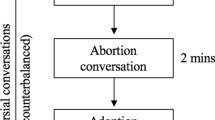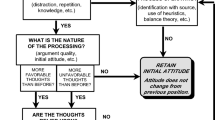Abstract
Two competing models of the social meaning and effects of eye gaze exist. One holds that different levels of eye gaze have clearly identifiable meanings that will yield main effects on such communication outcomes as hiring and interpersonal evaluations. The other holds that deviant levels of eye gaze are ambiguous in meaning and that interpretation depends on contextual cues such as the reward value of the violator. An experiment required 140 Ss to serve as interviewers during a structured interview in which six confederate interviewees sytematically varied three levels of eye gaze (high, normal, low) and two levels of reward (highly qualified, highly unqualified for the advertised position). Results favored a social meaning model over a violations of expectations model: Subjects were more likely to hire and rate as credible and attractive interviewees who maintained a normal or high degree of gaze than those who averted gaze. Interpretations given to higher amounts of gaze were more intimacy and similarity, more immediacy and involvement, and more composure, informality and nonarousal.
“The eyes of men converse as much as their tongues, with the advantage that the ocular dialect needs no dictionary, but is understood the world over.”
—Ralph Waldo Emerson
“These lovely lamps, these windows of the soul.”
—Guillaume de Salluste
“And I have known the eyes already, known them all—The eyes that fix you in a formulated phrase ...”
—T.S. Eliot
Similar content being viewed by others
References
Andersen, J.F., Andersen, P.A., & Jensen, A.D. The measurement of immediacy.Journal of Applied Communication Research 1979,7 13–180.
Argyle, M.The psychology of interpersonal behavior (2nd ed.. London: Penguin Books, 1972.
Argyle, M., & Dean, J. Eye contact, distance, and affiliation.Sociometry 1965,28 289–304.
Beebe, S.A. Effects of eye contact, posture and vocal inflection upon credibility and comprehension.Australian SCAN: Journal of Human Communication 1980,7 57–70.
Burgoon, J.K. A communication model of personal space violations: Explication and an initial test.Human Communication Research 1978,4 129–142. (a)
Burgoon, J.K. Attributes of the newscaster's voice as predictors of his credibility.Journalism Quarterly 1978,55 276–281, 300. (b)
Burgoon, J.K., & Aho, L. Three field experiments on the effects of violations of conversational distance.Communication Monographs 1982,49 71–88.
Burgoon, J.K., Buller, D.B., Hale, J.L., & deTurck, M.A. Relational messages associated with nonverbal behaviors.Human Communication Research 1984,10 351–378.
Burgoon, J.K., & Hale, J.L.Dimensions of relational messages. Paper presented at the Speech Communication Association Convention, Anaheim (November, 1981).
Burgoon, J.K., & Jones, S.B. Toward a theory of personal space expectations and their violations.Human Communication Research 1976,2 131–146.
Burgoon, J.K., Stacks, D.W., & Burch, S.A. The role of nonverbal violations of expectations in interpersonal influence.Communication 1982,11 114–128.
Burgoon, J.K., Stacks, D.W., & Woodall, G.W. A communicative model of violations of distancing expectations.Western Journal of Speech Communication 1979,43 153–167.
Ellsworth, P.C., & Langer, E.J. Staring and approach: An interpretation of the stare as a non-specific activator.Journal of Personality and Social Psychology 1976,33 117–122.
Exline, R. Explorations in the process of person perception: Visual interaction in relation to competition, sex, and need for affiliation.Journal of Personality 1963,31 1–20.
Fromme, D., & Bean, D. Dominance and sex differences in nonverbal responses to differential eye contact.Journal of Research in Personality 1974,8 76–87.
Goldberg, G.N., Kiesler, C.A., & Collins, B.E. Visual behavior and face-to-face distance during interaction.Sociometry 1969,32 43–53.
Hale, J.L., & Burgoon, J.K. Models of reactions to changes in nonverbal immediacy. Paper presented to the Second International Conference in Social Psychology and Language, Bristol, UK., 1983.
LaFrance, M., & Mayo, C.Moving bodies: Nonverbal communication in social relationships. Monterey, CA: Brooks/Cole., 1978.
McCroskey, J.C., Jensen, T., & Valencia, C. Measurement of the credibility of peers and spouses. Paper presented to the International Communication Association convention, Montreal, 1973.
McCroskey, J.C., & McCain, T.A. The measurement of interpersonal attraction.Speech Monographs 1974,41 261–266.
McCroskey, J.C., & Wright, D.W. The development of an instrument for measuring interaction behavior in small groups.Speech Monographs 1971,38 335–340.
Mehrabian, A.Silent messages. Belmont, CA: Wadsworth, 1971.
Moore, H.T., & Gilliland, A.R. The measurement of aggressiveness.Journal of Applied Psychology 1921,5 97–118.
Patterson, M.L. Compensation in nonverbal immediacy behaviors: A review.Sociometry 1973,36 237–252.
Patterson, M.L. An arousal model of interpersonal intimacy.Psychological Review 1976, 83, 235–245.
Snyder, R.A., & Sutker, L.W. The measurement of the construct of dominance and its relation to nonverbal behavior.Journal of Psychology 1977,97 227–230.
Stacks, D.W., & Burgoon, J.K. The role of nonverbal behaviors as distractors in resistance to persuasion in interpersonal contexts.Central States Speech Journal 1981,23 61–73.
Thayer, S. The effects of interpersonal looking duration on dominance judgments.Journal of Social Psychology 1969,79 285–286.
Thayer, S., & Schiffe, W. Observer judgment of social interaction: Eye contact relationship inferences.Journal of Personality and Social Psychology 1974,30 110–114.
Author information
Authors and Affiliations
Rights and permissions
About this article
Cite this article
Burgoon, J.K., Manusov, V., Mineo, P. et al. Effects of gaze on hiring, credibility, attraction and relational message interpretation. J Nonverbal Behav 9, 133–146 (1985). https://doi.org/10.1007/BF01000735
Issue Date:
DOI: https://doi.org/10.1007/BF01000735




